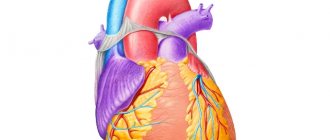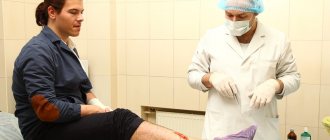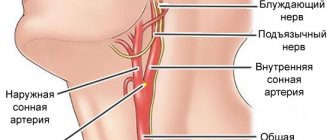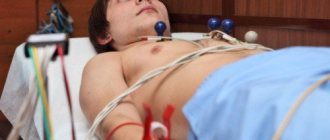Electrocardiography is included in the list of recommended studies for most patients, both adults and children. Therefore, its competent removal is an important skill for a medical specialist. The procedure involves sequentially performing the necessary steps and taking into account some features and nuances, which we will look into today.
Stages of the ECG procedure
Electrocardiography is a research method in which the electrical fields of the heart are recorded, provoked by contractions of the heart muscle. As a result, the specialist receives a cardiogram - an image of curve graphs. They can be displayed on a monitor or recorded on a special paper tape. To carry out this type of diagnosis, you need professional medical equipment - a cardiograph. This device consists of three required elements.
- An input device including electrodes, lead cables and their switches.
- Signal amplifier - allows you to amplify them to the value necessary for analysis.
- Recording unit for direct recording of a cardiogram.
When conducting an ECG, a specialist works sequentially with all these blocks, following a clear algorithm. It, in turn, is divided into several stages:
- preparing the room, equipment and patient for ECG;
- application of electrodes and connection of leads according to a specific scheme;
- adjusting the gain to correctly display the signal on the cardiogram;
- direct recording of the electrocardiogram.
For informative and reliable research results, it is necessary to avoid errors at each of these stages. Therefore, let’s take a closer look at their algorithms and features.
In what cases is an ECG prescribed?
A routine examination is indicated for all patients admitted to the hospital department. Unscheduled and emergency electrocardiography is carried out in case of development or suspicion of myocardial damage of any nature (toxic, inflammatory, ischemic).
Direct indications for an ECG are:
- metabolic syndrome;
- heartbeat instability;
- chronic diseases of the cardiovascular system;
- circulatory disorders;
- changes in myocardial structure;
- endocrine diseases;
- rheumatism;
- monitoring the operation of the pacemaker;
- chronic respiratory pathologies;
- preparation for surgery.
Medical indications for an ECG are:
- periodic pain in the chest, back, neck;
- shortness of breath and difficulty breathing both at rest and after physical exertion;
- high blood pressure;
- swelling of the lower extremities, constant weakness, fainting;
- previous stroke/myocardial infarction;
- age over 40 years (annually).
Pregnant women undergo electrocardiography upon registration, as well as in the presence of alarming symptoms (fainting, dizziness, changes in blood pressure).
An ECG is sometimes recommended in the following situations:
- medical examination (admission to kindergarten, school, secondary and higher educational institutions);
- preventive examination;
- before the driver's license test;
- issuing a certificate for visiting the pool and practicing active sports;
- registration for sanatorium treatment.
The procedure has no contraindications, except for patients with chest deformation, purulent wounds and inflammatory diseases of the skin in the thoracic area.
Installation of electrodes
Both reusable and disposable electrodes can be used to take an ECG. The first option is used more often in medical institutions, because is more economical. Kit includes:
- electrodes for limbs: 4 pieces;
- electrodes placed on the chest (one or 6);
- pears with suction cups.
Each electrode must be connected to a cable that matches its color. The designations must be memorized, because Most often there is confusion with them.
- A red cable is connected to the electrode on the right hand.
- On the left is yellow.
- The green wire is connected to the electrode on the left leg.
- On the right there will be a black, grounding cable that does not take readings.
Features of the event
- The patient exposes his body and lies down on the sofa. In this case, it is necessary to behave completely calmly;
- The health worker degreases the places where the electrodes will be attached with alcohol;
- A special gel is applied to the electrode plates, which conducts current well, as can be seen in the photo;
- The algorithm for applying electrodes is simple: electrodes are attached in the chest area, on the hands and ankles. In this case, the plates are fixed either with adhesive tape or with special suction cups;
- The algorithm for taking an ECG is as follows: the electrodes receive electrical impulses from the heart and transmit them through wires to the device itself, which processes them;
- Then the specialist turns on the device and begins recording ECG data. The device produces a long tape with a graph in the form of teeth of different heights. The monitoring data is deciphered by a doctor who will determine the diagnosis and prescribe treatment.
At the ProfMedPomoshch clinic you can get an ECG with interpretation and learn everything about the work of your heart.
Fixation of electrodes on the limbs
On the legs, a pair of electrodes are fixed on the inside of the lower leg at the very bottom. It must be remembered that a grounding sensor is attached to the right leg. On the hands, electrodes are attached to the forearms.
With standard leads, indicators are taken as follows:
- left and right hands - first position;
- right arm and left leg - second position;
- left leg and arm - third position.
Thus, an Einthoven triangle is obtained, each side of which corresponds to one and possible leads.
Enhanced leads involve collecting a signal using one electrode, which records the potential difference between the area where it is applied and the conventional electrical zero. They have the following designations:
- right hand - aVR;
- left hand - aVL;
- left leg - aVF.
How does it work
Electrodes placed on the patient's body receive weak electrical currents that originate in the heart. As they become stronger, they are recorded using a galvanometer. Any changes in ripple are transmitted to a special device, which produces data in the form of a broken line on a paper tape.
The next important stage of the examination is the decoding of the data that the doctor deals with. The fact is that the teeth on the tape are sized according to special standards. If there are any deviations from the norm, then there is a health problem. And only a specialist can correctly decipher the cardiogram and establish an accurate diagnosis.
In order for the results of an ECG to be reliable, there is no special preparation, but some rules must be followed.
Fixation of electrodes in chest leads
If a single-channel study is carried out, then only one electrode is used. But in modern ECGs, for more accurate diagnosis, in most cases, 6 are used. They are designated by the Latin letter V and are superimposed at the following points:
- V1 - at the right edge of the sternum in the 4th intercostal space, the red wire is connected;
- V2 - also in the 4th intercostal space, but on the left edge of the sternum, wire color - yellow;
- V3 - in the middle between the 4th and 5th intercostal spaces along the left line, connect the green cable;
- V4 - along the midclavicular line in the 5th intercostal space, wire color - brown;
- V5 - along the anterior axillary line in the 5th intercostal space, connected to a black cable;
- V6 - in the middle of the axillary line at the same level with V450m, the wire color is blue (possibly purple).
Last news
Happy Victory Day!
Let it never be forgotten what an ordinary person did during the war. Soldier, peasant, youth and boy. They believed so strongly in luck, in the country, in themselves, and they knew for sure that they would not give Russia up to anyone. Let the fireworks fly up on this day, let the songs of those distant years be sung today. Happy Victory Day!
“Healthcare Week in the Republic of Bashkortostan” We invite you to visit and take part in the V Medical Forum-Exhibition “Healthcare Week in the Republic of Bashkortostan” from April 7 to April 10, 2021 in Ufa, at the VDNH-EXPO exhibition complex.
“Possibilities of cancer prevention and complementary methods in oncology” March 20-22 - an unprecedented event!! II annual Conference “PreventAge-medicine - the crossroads of 7 roads” “Modern opportunities and prospects for cancer prevention and complementary methods in oncology”
Conference We invite you to take part in the next event that continues the educational traditions of the Kazan School of Orthopedic Traumatologists.
Anniversary of the City Center for Endoscopic Urology As part of the conference, about 30 surgical interventions on most pathologies of the human urinary system will be broadcast in parallel on three screens in 3D.
XII International Symposium on Sports Medicine XII International Symposium on Sports Medicine and Rehabilitation under the auspices of the First Moscow State Medical University named after. THEM. Sechenov. October 19-20, Moscow. Two days, more than 30 reports, master classes, exhibition exposition.
How to undergo an ECG without problems, so that there are no difficulties in making a diagnosis?
POSITION
about the processing of personal data
This Regulation defines the policy, procedure and conditions of the Operator regarding the processing of personal data, establishes procedures aimed at preventing and identifying violations of the legislation of the Russian Federation, eliminating the consequences of such violations related to the processing of personal data. All issues related to the processing of personal data that are not regulated by these Regulations are resolved in accordance with current legislation
Russian Federation in the field of personal data.
1) directly personal data.
regarding the processing of personal data, with this Regulation and amendments to it. Training of these employees is organized by the structural unit for advanced training in accordance with schedules approved by the Operator.
subject to the prior consent of the subject of personal data. Consent may be oral or written.
The specified processing of personal data is considered to be carried out without the prior consent of the subject of personal data, unless the Operator proves that such consent has been obtained.
ensuring the protection of personal data processed by the Operator from unauthorized or accidental access to it, destruction, modification, blocking, copying, provision, distribution of personal data, as well as from other unlawful actions in relation to personal data;
exercise internal control over compliance by his subordinates with the requirements of the legislation of the Russian Federation in the field of personal data, including requirements for the protection of personal data;
bring to the attention of the Operator’s employees the provisions of the legislation of the Russian Federation in the field of personal data, local acts on the processing of personal data, requirements for the protection of personal data;
organize the reception and processing of requests and requests from personal data subjects or their representatives, as well as monitor the receipt and processing of such requests and requests;
in case of violation of the requirements for the protection of personal data, take the necessary measures to restore the violated rights of personal data subjects.
have access to information regarding the processing of personal data entrusted to him and including:
purposes of processing personal data;
categories of personal data processed;
categories of subjects whose personal data is processed; legal grounds for processing personal data;
a list of actions with personal data, a general description of the methods used by the Operator for processing personal data;
description of the measures provided for in Art. Art. 18.1 and 19 of the Federal Law of July 27, 2006 N 152-FZ “Personal Data”, including information on the availability of encryption (cryptographic) means and the names of these means;
date of commencement of processing of personal data;
term or conditions for termination of processing of personal data;
information about the presence or absence of cross-border transfer of personal data during their processing;
information on ensuring the security of personal data in accordance with the requirements for the protection of personal data established by the Government of the Russian Federation;
involve other employees of the Operator in the implementation of measures aimed at ensuring the security of personal data, assigning them the corresponding duties and assigning responsibility.
executive power, internal documents of the Operator, as well as the reasons and conditions that contributed to the commission of the violation.









